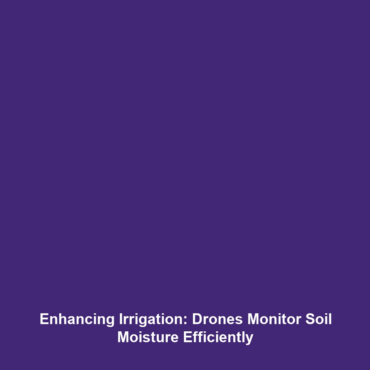Drones Used to Monitor Soil Moisture Levels and Improve Irrigation Efficiency
Introduction
Drones have become an essential tool in modern agriculture, particularly for monitoring soil moisture levels and enhancing irrigation efficiency. This technology allows for precise data collection, reducing water waste and improving crop health. As concerns over water scarcity and sustainable farming practices grow, understanding the role of drones in efficiently managing irrigation systems is vital. In the broader context of Drones in Science, these flying sensors represent a significant advancement that can transform agricultural practices worldwide.
Key Concepts
Drones used to monitor soil moisture levels operate by utilizing various sensors, including thermal imaging and multispectral cameras, to gather data on soil conditions.
Principles of Operation
- Remote Sensing: Drones can cover vast agricultural areas quickly, using sensors that detect differences in moisture levels.
- Data Analytics: The data collected is processed using software that interprets soil moisture content, informing farmers when and where to irrigate.
- Precision Agriculture: This approach integrates technology to maximize crop yields while minimizing resource use.
Applications and Real-World Uses
There are numerous applications of drones for monitoring soil moisture and enhancing irrigation efficiency in various agricultural settings. Some significant examples include:
- Crop Health Monitoring: Drones can assess plant health by analyzing soil moisture levels, guiding irrigation practices.
- Water Resource Management: Efficient irrigation leads to optimized water usage, crucial in drought-prone regions.
- Sustainable Farming: Adoption of drones contributes to sustainable agriculture by reducing over-irrigation and runoff.
Current Challenges
Despite their benefits, the use of drones in monitoring soil moisture levels faces several challenges:
- Regulatory Issues: Compliance with local drone regulations can limit operational flexibility.
- Technical Limitations: Variability in sensor accuracy can affect data reliability.
- High Initial Costs: Investment in drone technology can be prohibitively expensive for small-scale farmers.
Future Research and Innovations
Future research and developments in drone technology promise to enhance capabilities in monitoring soil moisture and improving irrigation. Innovations include:
- AI Integration: Advanced algorithms for data processing can yield more accurate predictions for irrigation needs.
- Enhanced Sensors: Development of next-gen sensors for real-time soil moisture assessment.
- Autonomous Systems: Fully automated drones that not only monitor but also manage irrigation systems effectively.
Conclusion
Drones are revolutionizing the way we monitor soil moisture levels and enhance irrigation efficiency, fitting seamlessly into the broader framework of Drones in Science. As technology continues to advance, these aerial devices can lead to more sustainable agricultural practices while addressing global water challenges. For farmers and researchers alike, staying informed about the latest developments in drone technology is crucial. Explore more about sustainable farming practices and the role of technology in agriculture on our website.

Leave a Reply